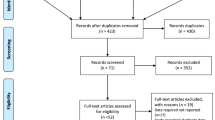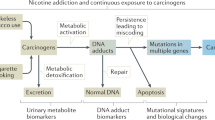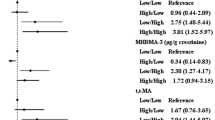Abstract
Background: Two epidemiologic studies have reported an inverse association between use of phenobarbital (PB) and bladder cancer development. It was proposed that PB use protects against bladder cancer by inducing enzymes that participate in the detoxification of human bladder carcinogens, such as the aminobiphenyls and naphthylamines, which are found in cigarette smoke. Methods: A population-based case–control study was conducted in Los Angeles, California, involving 815 incident bladder cancer cases and an equal number of controls who were matched to the index cases by neighborhood, sex, date of birth (within 5years), and race. Detailed information on lifetime use of PB was collected through in-person interviews. Results: Ever use (20 or more times over lifetime) of PB was not associated with risk of bladder cancer (OR: 0.86; 95% CI: 0.54, 1.39). Regular use of PB also was not associated with risk of bladder cancer in either men or women, in either smokers or non-smokers, although the number of regular users in cases and controls were relatively small (21 cases vs. 15 controls, OR: 1.20; 95%CI: 0.59, 2.45). In fact, compared with non-users, subjects in the highest category of lifetime PB consumption were at a non-significant 2.46-fold increased risk of bladder cancer (95% CI: 0.90, 6.78). Conclusions: The present study did not observe a protective role of PB use in bladder cancer development in the general population.
Similar content being viewed by others
References
Boring CC, Squires TS, Tong T, Montgomery S. Cancer statistics, 1994. CA Cancer J Clin 1994; 44: 7–26.
Yu MC, Ross RK. Epidemiology of bladder cancer. In: Petrovich Z, Baert L, Brady LW (eds), Carcinoma of the Bladder. Innovations in Management 1998; 1–13.
Olin BR (ed.), Drugs Facts and Comparisons, 1992 edn., St Louis, MO: Facts and Comparisons, 1992, p. 1336.
Olsen JH, Boice JD Jr, Jensen JP, Fraumeni JF Jr. Cancer among epileptic patients exposed to anticonvulsant drugs. J Natl Cancer Inst 1989; 81: 803–808.
Olsen JH, Wallin H, Boice JD Jr, Rask K, Schulgen G, Fraumeni JF Jr. Phenobarbital, drug metabolism, and human cancer. Cancer Epidemiol Biomarkers Prev 1993; 2: 449–452.
Wallin H, Skipper PL, Tannenbaum SR, Jensen JP, Rylander L, Olsen JH. Altered aromatic amine metabolism in epileptic patients treated with phenobarbital. Cancer Epidemiol Biomarkers Prev 1995; 4: 771–773.
Bernstein L, Ross RK. Cancer in Los Angeles County. A Portrait of Incidence and Mortality 1972-1987. Los Angeles, CA: University of Southern California, 1991.
Breslow NE, Day NE. Statistical Methods in Cancer Research, Vol. I: The Analysis of Case-Control Studies. Lyon, France: IARC Scientific Publications, 1980; 32: 5-338.
Castelao JE, Yuan J-M, Gago-Dominguez M, Yu MC, Ross RK. Non-steroidal anti-inflammatory drugs and bladder cancer prevention. Br J Cancer 2000; 82: 1364–1369.
Gago-Dominguez M, Castelao JE, Yuan J-M, Yu MC, Ross RK. Use of permanent hair dyes and bladder cancer risk. Int J Cancer 2001; 91: 575–579.
Habel LA, Bull SA, Friedman GD. Barbiturates, smoking, and bladder cancer risk. Cancer Epidemiol Biomarkers Prev 1998; 7: 1049–1050.
Yu MC, Skipper PL, Taghizadeh K, et al. Acetylator phenotype, aminobiphenyl-hemoglobin adduct levels, and bladder cancer risk in white, black, and Asian men in Los Angeles, California. J Natl Cancer Inst 1994; 86: 712–716.
Imaida K, Wang CY. Effect of sodium phenobarbital and sodium saccharin in AIN-76A diet on carcinogenesis initiated with N-[4-(5-nitro-2-furyl)-2-thiazolyl] formamide and N,N-dibutylnitrosamine in male F344 rats. Cancer Res 1986; 46: 6160–6164.
Wang CY, Garner CD, Hirose M. Effect of phenobarbital on the carcinogenesis of N-[4-(5-nitro-2-furyl)-2-thiazolyl]formamide in rats. Cancer Lett 1983; 19: 305–310.
Diwan BA, Hagiwara A, Ward JM, Rice JM. Effects of sodium salts of phenobarbital and barbital on development of bladder tumors in male F344/NCr rats pretreated with either N-[4-(5-nitro-2-furyl)-2-thiazolyl] formamide or N-nitrosobutyl-4-hydroxybutylamine. Toxicol Appl Pharmacol 1989; 98: 269–277.
Nakanishi K, Fukushima S, Hagiwara A, Tamano S, Ito N. Organ-specific promoting effects of phenobarbital sodium and sodium saccharin in the induction of liver and urinary bladder tumors in male F344 rats. J Natl Cancer Inst 1982; 68: 497–500.
Tsuda H, Fukushima S, Imaida K, Kurata Y, Ito N. Organ-specific promoting effect of phenobarbital and saccharin in induction of thyroid, liver and urinary bladder tumors in rats after initiation with N-nitrosomethylurea. Cancer Res 1983; 43: 3292–3296.
Ito N, Nakanishi K, Hagiwara A, Shibata M, Fukushima A. Induction of hyperplastic liver nodules by phenobarbital in rats initiated with N-butyl-N-(4-hydroxybutyl) nitrosamine. Gann 1980; 71: 918–919.
Hirose M, Shirai T, Tsuda H, Fukushima S, Ogiso T, Ito N. Effect of phenobarbital, polychlorinated biphenyl and sodium saccharin on hepatic and renal carcinogenesis in unilaterally nephrectomized rats given N-ethyl-N-hydroxyethylnitrosamine orally. Carcinogenesis 1981; 2: 1299–1302.
Ward JM. Increased susceptibility of livers of aged F344/NCr rats to the effects of phenobarbital on the incidence, morphology, and histochemistry of hepatocellular foci and neoplasms. J Natl Cancer Inst 1983; 71: 815–823.
Whysner J, Montandon F, McClain RM, et al. Absence of DNA adduct formation by phenobarbital, polychlorinated biphenyls, and chlordane in mouse liver using the 32P-postlabeling assay. Toxicol Appl Pharmacol 1998; 148: 14–23.
International Agency for Research on Cancer. Phenobarbital and phenobarbital sodium. In: Some Miscellaneous Pharmaceutical Substances, IARC Monograph on Evaluation of the Carcinogenic Risk of Chemicals in Man, Vol. 13, Lyon, France: IARC 1977; 157–181.
Hiasa Y, Kitahori Y, Ohshima M, et al. Promoting effects of phenobarbital and barbital on development of thyroid tumors in rats treated with N-bis(2-hydroxypropyl) nitrosamine. Carcinogenesis 1982; 3: 1187–1190.
Yuan J-M, Castelao JE, Gago-Dominguez M, Ross RK, Yu MC. Hypertension, obesity and their medications in relation to renal cell carcinoma. Br J Cancer 1998; 77: 1508–1513.
Gago-Dominguez M, Yuan J-M, Castelao JE, Ross RK, Yu MC. Regular use of analgesics is a risk factor for renal cell carcinoma. Br J Cancer 1999; 81: 542–548.
Author information
Authors and Affiliations
Rights and permissions
About this article
Cite this article
Castelao, J., Gago-Dominguez, M., Yuan, JM. et al. Phenobarbital use and bladder cancer risk. Eur J Epidemiol 18, 659–664 (2003). https://doi.org/10.1023/A:1024851324274
Issue Date:
DOI: https://doi.org/10.1023/A:1024851324274




